String performance weeks
There are lots of different performances you will make as a musician and many of those are in the familiar, relative safety of the orchestra in which you regularly practice and perform. There comes a time, however, in a musician’s life when you take the next step up and prepare for a solo performance.
For the last two weeks, the String Department has held our Term 4 performances and placement auditions for next year. We have had the pleasure of listening to wonderful performances and have been really excited to hear the amazing progress that students have made this year.
Solo playing can be very different from playing within a group or section and in preparing for these performances, our students have shown great self-motivation and discipline. Our teachers have been preparing our group lesson students for these performances, in a supportive and understanding way, as they gently guided and supported them through this important, but sometimes daunting, process.
While we asked students to prepare their own choice piece, the performances also included a combination of scales, hand pattern exercises, bowing, tone, string crossing, and/or rhythm activities. Our favourite part of the performances were the orchestral excerpts that were taken directly from pieces performed at the String Spring Concert and, of course, sight-reading! We highly value sight-reading because, when reading a new piece of music for the first time, the panel of teachers can get a real understanding of the application of all previous knowledge and skills in a real-time, realistic scenario. All students sight-read, especially at the start of the year, and knowing how students can read and apply their musical skills and knowledge is important to how we shape groups for the new year. In this way, these performances are like a miniature exam in that we ask students to prepare a variety of activities to get a good understanding of the student’s strengths and any areas that might require further development.
In placing students for new ensembles, we also look at the progress made by the student over the whole year. So, while the Term 4 performance is the latest achievement/information we gather, it’s not the only factor that will determine a students’ placement in an orchestra for next year.
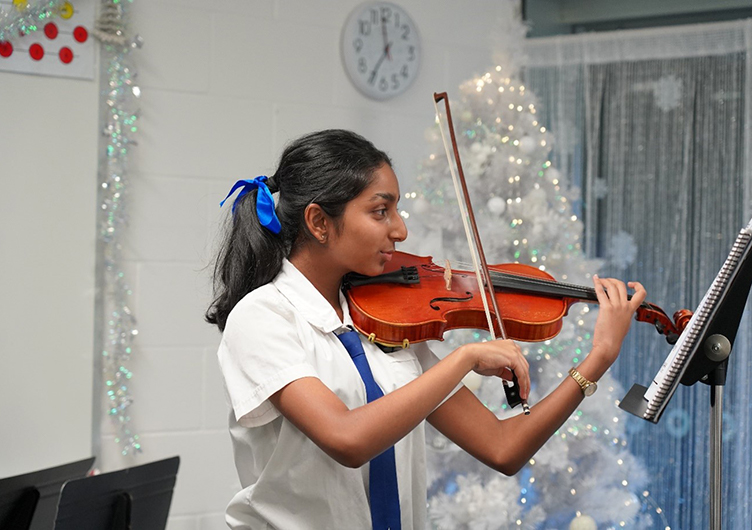
Thenuri Basnayake (11H) displaying her solo performance skills
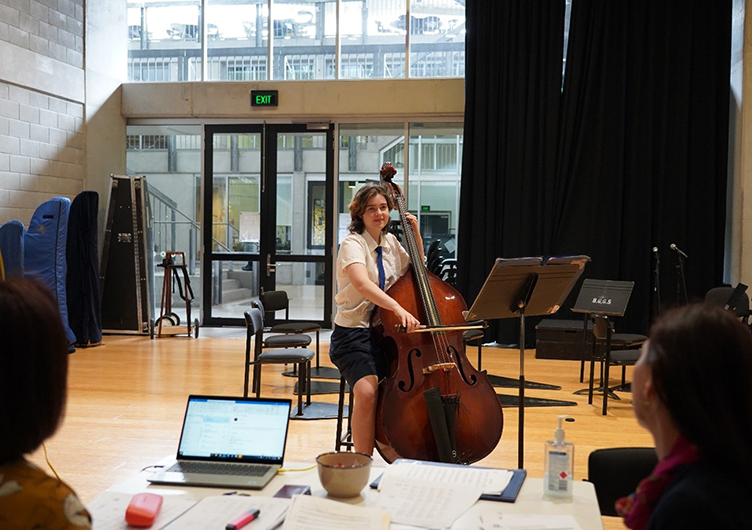
Amelia Howell-Smith (9L) under the observant eyes of Mrs Connie Garrett-Benson and Mrs Helen Sharp
String Spring Concerts
On Tuesday night, we were all wowed by the energy and movement, and sheer abundance of musical abilities and talents, of our string ensembles and extension ensembles who performed in the String Spring Concerts.
The depth of the musical performances was truly impressive with students presenting a vast array of musical styles and genres inspired by different cultures and times. Elgar Strings showed off their amazing progress this year and performed Hiawatha by Soon Hee Newbold and Ninja by Meyer. Dvorak strings took us on an adventurous journey to the desert with Sahara Crossing by Meyer, A Spark of Courage by Doug Spata, and Spring Fever by Kathryn Griesinger.
Copland Strings delighted us with the sounds of Kabuki Dance by Meyer, a piece that captured the essence of traditional Kabuki theatre, a drama using colourful costumes, song, and dance, and, Bells of Genghis Khan by Stephen Chin, which depicts the larger-than-life character Genghis Khan and his ruthlessness.
Bartok strings blasted off on an intergalactic adventure in Terra Nova by Meyer, celebrated the return of the clear, warm weather in When the Summer Comes by Susan H Day and took us back to the stylish 1960s in a Latin-inspired piece titled Spy vs. Spy by Chris Thomas.
Albinoni transported us to the high seas with Russian Sailor’s Dance by Reinhold Gliere from the Red Poppy ballet before going back to calmer waters with River Song by Keith Sharp. Finally, they were joined by Aurora Lin (7B), Savannah Munro (7R), and Shantell Johnson (9M) on the harp to perform Rise of the Olympians by Brian Balmages—an epic piece that exemplified the excitement and anticipation of the Olympic games.
Celtic ensemble invited us to the Scottish countryside with a suite of traditional tunes Drummond Castle, Muckin’ ‘o’ Geordies Byre, and The Gael, then followed up with Kingdom Dance from Disney’s Tangled. Gypsy Band began with two pieces arranged by Mr Patterson Joska: A Gypsy Romance and Bride in a Red Dress. Their final piece, titled Sol Schjohn Kumn di Ge’ule, a Yiddish tune, had been collaboratively arranged by Gypsy Band with help from their director, Ms Duncan.
Mendelssohn and Chamber Strings combined forces to perform The Emerald Falcon by Richard Meyer. At times menacing and sometimes lyrical and mysterious, the lovely middle section featured Irene Shim (11G) with an extended violin solo and a beautifully tranquil solo for Brielle Porter (9O) on double bass. It was frightening, mysterious, and peaceful. Orion and the Scorpion, by Soon Hee Newbold, portrays a fantastical flight and journey that takes us through the constellations and Orion’s belt to witness the birth of stars and wonders of our universe. And to finish concert A, we heard a piece from a recent Disney film we just don’t talk about … We Don’t Talk About Bruno, arranged by Alison Gillies.
Vivaldi Strings led us on a thrilling musical journey that fired the imagination and evoked images such as those in Aladdin, set as one continuous work, Arabian Dreams by Soon Hee Newbold. Vivaldi Strings concluded concert B, joined by Liv Evans (10O) and Vani Ranjan (10G) on percussion, and Iha Agrawal (10R) and Lucinda Isbel (10H) on voice, performing Radioactive by Imagine Dragons. This electronic rock and pop rock song, arranged by Larry Moore, showed inspiration from the Pentatonix (an American acapella group) and Lindsey Stirling (American violinist) cover.
Thank you to the Music Support Group parent volunteers for their help with the barbeque and extra help on the night. Kiara Chang (11B) did an excellent job as our MC for the night and a big thank you to all the parents and friends who came to watch. Thank you to Ms Harper for all her help in the lead-up and then on the night of the concerts, Ms McCabe for her technical support, and all the talented and dedicated student performers for making the night such a wonderful success. One last, big thank you goes to all our string orchestra directors—Mr Zorzetto, Ms Pollicina, Ms Duncan, Ms Sharp, and Ms Garrett-Benson for your tireless efforts not just on the night, but for a whole year of exceptional music-making, and all those fabulous before and after School rehearsals.
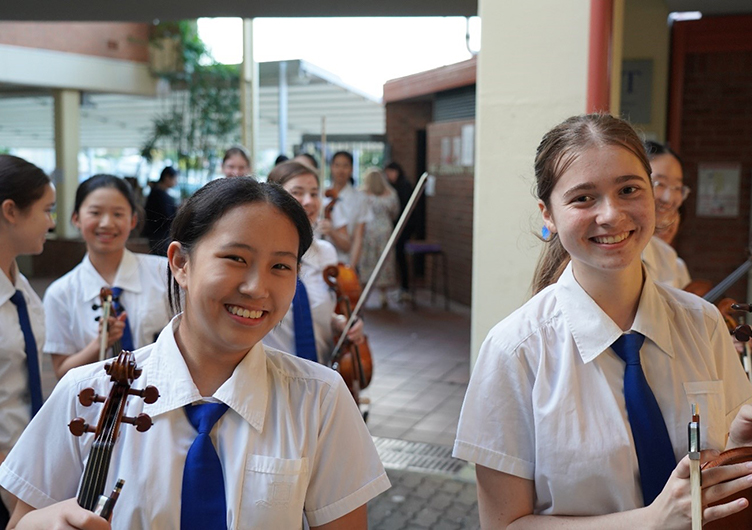
Charlize Chang (10H) and Elizabeth Fox (110) moments before taking the stage
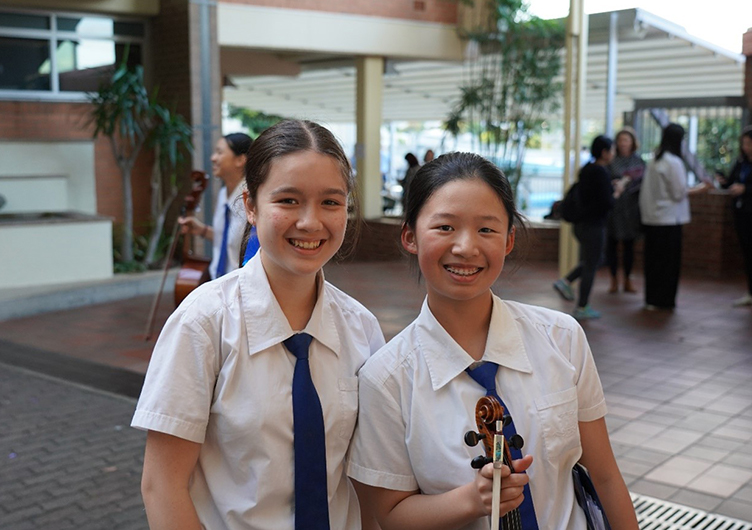
Zara Hosking (10G) and Holly Xu (9O) getting ready to perform
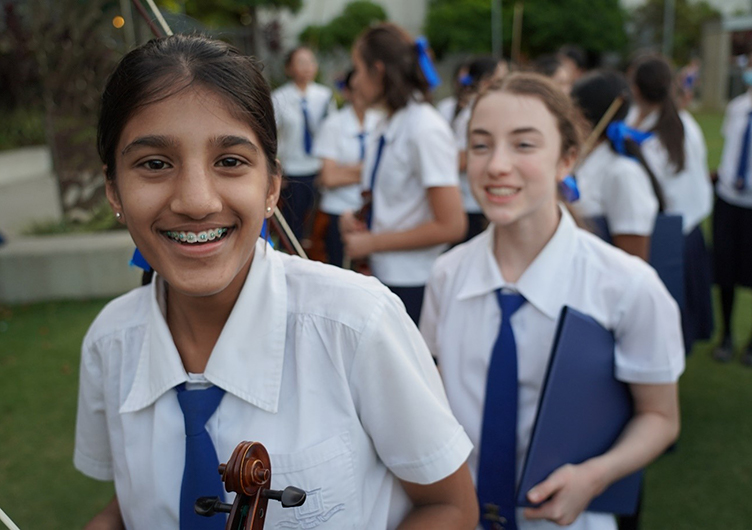
Thisali Wijesundera (7G) and Klara Coburn (7G) making their way to stage at the String Spring Concert
Chamber Music and Chocolate concert
Who knew that chocolate and chamber music were such a great match? Well, all our chamber music ensembles did! On Wednesday at lunchtime this week, they shared this knowledge in their last performance of the year with an audience of music and chocolate lovers. We heard a lovely mixed bag of music from Beethoven to Swift and from Howl’s Moving Castle to Haydn. It was a true celebration of chamber music. A big shout out to all our chamber music teachers for working their musical magic and for the students who performed so well on the day. It was great to see so many students enjoying the sweet, sweet sounds of chamber music as it floated around the Annie Mackay Room through the main building, and from the String Room up into the CLC.
We look forward to providing more informal lunchtime chamber music concerts next year, and hopefully some more chocolate, too!
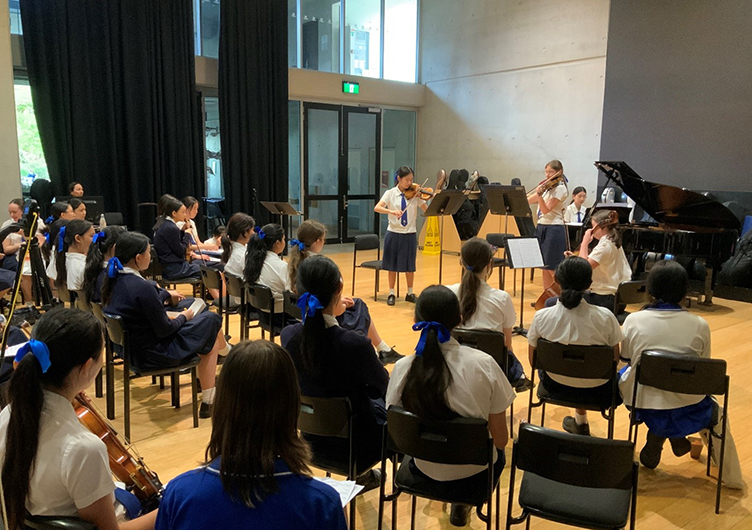
The appreciative audience enjoying the gift of chamber music performances by the BGGS students
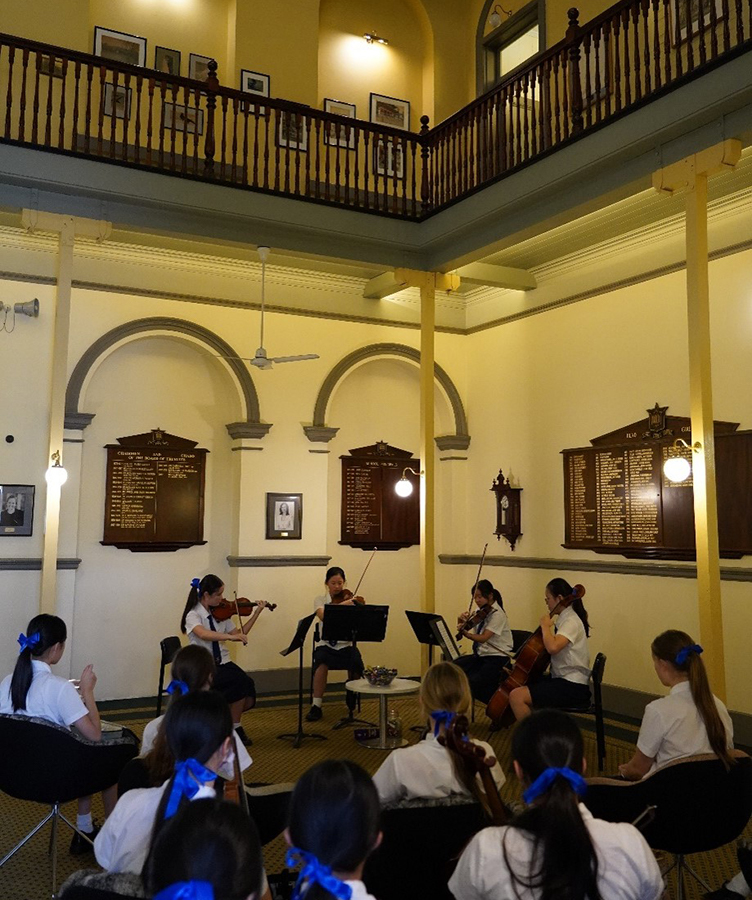
The soaring ceiling height makes a beautiful acoustic that our BGGS chamber groups filled with delightful music
Commissioning Female Composers Initiative
Each year at BGGS, we hold our International Women’s Day (IWD) Concert where we present works by female composers. We feature student compositions, established and emerging professional composers, and we also commission new works to be presented. In 2020, we commissioned Ms Catherine Likhuta to write an original piece for Symphonic Winds, Through Healers’ Eyes.
In Ms Likhuta’s own words, ‘The piece was inspired by the life story of a Brisbane nurse, Grace Wilson, in particular, her work as a high-ranked army nurse with the Australian Army Nursing Service during World War I and the early years of World War II. Interestingly, my great-grandmother, Lydia Holovko, who helped raise me, was also a war nurse, though on the other side of the world—in Ukraine. As a result, this topic was very close to my heart. This piece is an emotional depiction of war as seen by war nurses, the way I imagine it. It is about healing, courage, compassion, patience, care, battle, reflection, and perseverance’.
The work caught the attention of The University of Queensland’s School of Music, who commissioned Ms Likhuta to arrange the piece for symphony orchestra. You can view the YouTube video of the world premiere performance of the orchestral arrangement here.
We are very proud of our heritage and reputation for championing women composers, and we are pleased to see this initiative have ongoing effects beyond the School.
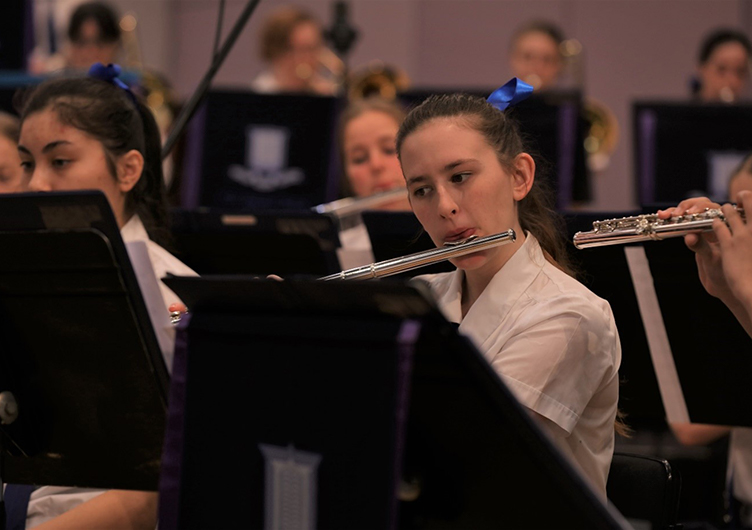
Tiarne Graves (2020) performing with Symphonic Winds
Private lesson availability
As you may be aware, in addition to our group Instrumental Music tuition available at BGGS, we also offer private tuition via a wide variety of instrument and voice specialist teachers at the School. Some students participate in both group and private tuition—these students largely report that both forms of tuition offer extensive benefits. Our small group tuition allows students the opportunity to work with a few of their friends to collaborate and gain experience in building a repertoire base, intonation, rhythmic stability, balancing, and blending. While private tuition allows students to receive guidance on specific and tailored techniques related to their instrument or voice, and perhaps work towards sitting an AEMB exam or similar.
Although group tuition is included in a student’s school fees, private lessons attract an additional charge and are invoiced directly by the teacher. Students can request a specific teacher or have a teacher allocated to them once enrolled. Further information, including rates and instrument-specific details, can be found in the Instrumental Music Handbook available here.
If you have any questions that are not answered in the Instrumental Music Handbook, you are welcome to contact the Instrumental Music Administration at music@bggs.qld.edu.au.
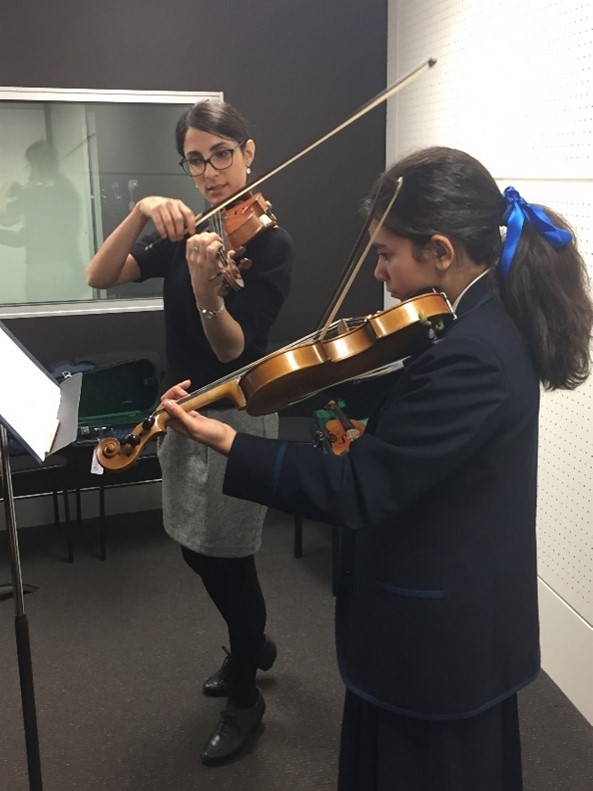
Ms Josie Pollicina (violin) with Siddhi Bhandarker (11W)
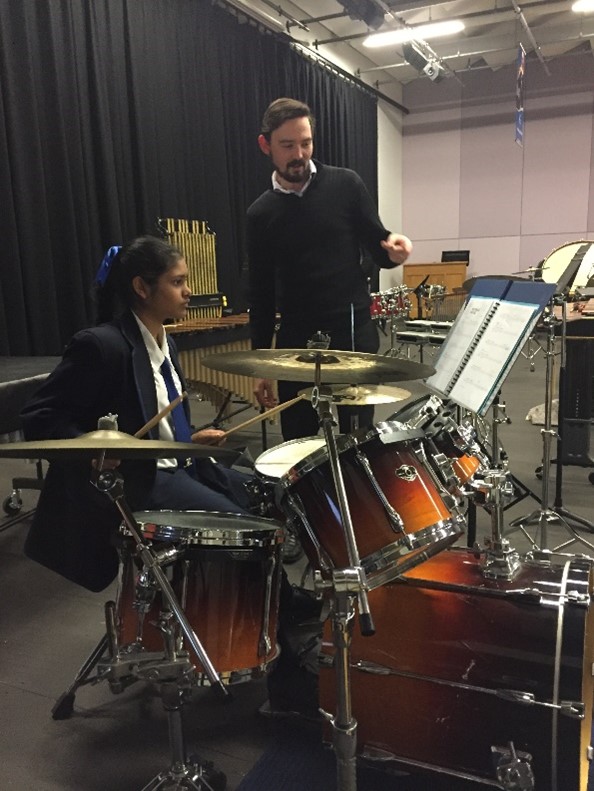
Mr Jacob Cavanough (percussion) in a lesson with Karen Sundar (2019)
MSG News
A big thank you to everyone who helped at the Spring Band and String concerts over the past two weeks. Both nights were extremely busy, and we are so grateful to those who gave up some time to cook and serve at the BBQ and bar.
We will be running the sausage sizzle for the Carols under the Stars night on Monday 28 November and would deeply appreciate any assistance you could offer. Shifts are in blocks of one hour so that you can work around your daughter’s performances. Please sign up via this link.
If you have any questions, please contact us at msgbggs@gmail.com.
We are so appreciative of the wonderful supporters who volunteer their time to supporting the BGGS Instrumental Music Program. Even if you can’t volunteer for the committee, our parent helpers who staff barbeques, bars, and attend meetings are all vital structures of support for our wonderful Instrumental Music Program. Following the Music Support Group’s AGM on Thursday evening, the committee positions were filled by the following volunteers.
President—Christine Trappett
Vice President—Leah Barrett-Beck
Secretary—Rowena Sommerfeld
Treasurer—Michelle Dingle
Purchasing Coordinator—Karen Stafford
How playing a musical instrument can affect the brain

Some of our BGGS Symphony Orchestra brass and percussion musicians performing at the 2022 Cathedral Concert
Much study has been conducted and documented regarding how playing a musical instrument can positively influence behaviour, organisation, academic achievement, interpersonal relationships, and much more. Though these elements are important when coupled with the social-emotional benefits related to music performance, it is equally important to understand why these characteristics can be developed by studying a musical instrument.
In most instances, the answer comes back to how the human brain reacts and activates when being challenged by performing on a musical instrument. Most, if not all, of the auditory, visual, and motor areas of the brain ignite when creating music with the human body.
In addition to the limbic system (emotion centre) of the brain, musicians also develop the structural and functional centre of the brain, known as the hippocampus, over many years of studying music performance. This contributes to the whole-brain workout that musicians achieve when performing music. This also may explain why scans and studies of musicians’ brains, of all ages, demonstrate advanced development of the corpus callosum—a large bundle of nerve fibres that connect both sides of the brain.
Arguably, the greatest benefit of all these features of studying music performance is the discovery that the act of creating music can stimulate neurogenesis—the formation of new neurons that service learning and memory. A part of this is the implied or inherent ability for musicians to recognise large-scale patterns in music—whether that be visual, aural or emotive patterns. These patterns can appear at the microscopic level (every bar or beat), but importantly they also appear at the macroscopic level (several phrases or movements that can occupy large quantities of time). The ability of the musician to recognise these large-scale patterns is, partly, what is so compelling about the study of the musician’s brain. For example, composers like Beethoven, Mozart, Bach, etc reportedly did not write music a bar at a time, listen to it, and then decide whether they ‘liked’ it or not. These composers largely knew exactly what the composition was going to sound like before they even wrote the music on paper. And some of these compositions involved scores of instruments and last for well over an hour.
An excellent web page that contains a video and associated transcript of this phenomenon, and links to further reading, can be found here.
Mr Paul Johnston
Assistant Director of Instrumental Music
Looking Ahead
- Band Performance Weeks (continued auditions)—Week 6
- Speech Night—Thursday 17 November
- Christmas Carnival—Monday 28 November




